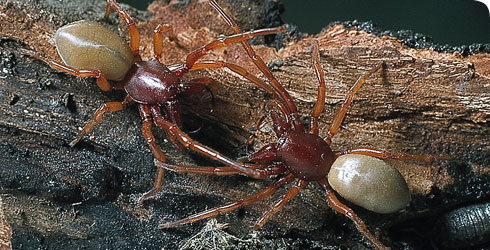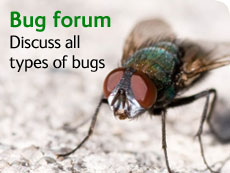UK spider bites
In the UK, spiders are not normally thought of as hazardous to health. So it may come as a surprise that a dozen or more species resident in the UK are capable of causing a significant or unpleasant bite.
Bite reports
The incidents quoted below are all considered to have been genuine cases of spider bite. They are cases where the specimen was submitted for identification to the Natural History Museum, and accompanied by an account of the bite and its symptoms.
- Report 1: Tube web spider, Segestria florentina
- Report 2: False widow spider, Steatoda nobilis
- Report 3: Woodlouse spider, Dysdera crocata
- Report 4: Walnut orb-weaver spider, Nuctenea umbratica
- Report 5: False widow spider or cellar spider, Steatoda grossa
- Report 6: Lace weaver spider, Amaurobius similis
- Report 7: Black lace weaver spider, Amaurobius ferox
- Report 8: Mouse spider, Scotophaeus blackwalli
- Report 9: Rustic wolf spider, Trochosa ruricola
- Report 10: Bark sac spider, Clubiona corticalis
- Report 11: Stone spider, Drassodes lapidosus
- Report 12: Cross or garden spider, Araneus diadematus
- Report 13: Bruennichi's Argiope, Argiope bruennichi
- Report 14: Money spider, Leptohoptrum robustum
Non-native species regularly imported with fruit
- Report 15: Exotic sac spider, Cheiracanthium
- Report 16: Huntsman spider, Heteropoda venatoria
- Report 17: Black widow spider, Latrodectus mactans
- Report 18: False widow spider, Steatoda paykulliana
Explanatory notes
- Body size
is measured from the eyes of the spider to the base of the spinnerets, not including the jaws, palps or legs. - Season
is the period when specimens are fully grown (adult), which is also the period when most bites occur. - First recorded in the UK
is an attempt to distinguish long established species from relatively recent colonists. Those that were included in the benchmark publication of Lister (1678) are considered to be original native species. - Reports of bites
are quotations from letters to the author (Paul Hillyard) by people who reported bites, except where indicated, e.g.'from literature'.
More information
Typical symptoms of a spider bite in the UK are local pain, swelling and reddening. Countrywide, the incidence of bites is not high (perhaps a number in 10s or 100s each year) but, with the relatively recent spread in the UK of some colonising species, the frequency appears to be increasing. However, there are no statistics collected nationwide. Thus reports help alert people, including medical practitioners, to the reality that the UK has a number of spiders that can and do cause bites.
In this country, 90 to 100 per cent of the bite cases are caused by no more than 12 of the approximately 700 native species. Of all the remaining species, the great majority are quite harmless, in spite of having venom, and have no history of biting humans. Furthermore, the increase in bite cases is believed to be linked to just 2 species of exotic spiders that have become established here and are now spreading widely.
The spiders that have recently colonised this country have done so in one of two ways. Either they have been transported here via imported goods, or they have introduced themselves, quite naturally, as part of a northward migration within Europe. In their original territory they tend to live in the open, But, in the colder climate of the UK, they adapt readily to sheltered, urban environments. Thus they occur in and around buildings, with inevitably close contact to humans.
When considering spider bites, caution is necessary because it is well known that spiders often get the blame for bites and stings that are actually caused by insects or even plants. Nevertheless, the incidents quoted in this report are all considered to have been genuine cases of spider bite.


